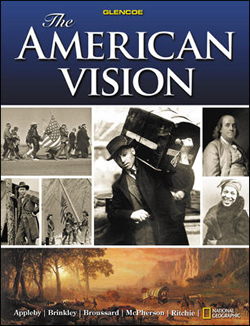The American Vision © 2008Chapter 6:
The Spirit of ReformWeb Lesson PlansIntroduction
Students have read about the national reform movement of the early 1800s. In this activity students will investigate the early abolition movement to learn about the methods and goals of its leaders.
Lesson Description
Students will use information from the Africans in America Web site to learn about the abolition movement of the first half of the 1800s. They will read about several leaders in the anti-slavery movement, the response by pro-slavery activists, and the movement's influence on national politics. Students will also read several passages from important abolitionist writings. They will then answer four questions and apply this information by writing a newspaper article about Henry Highland Garnet's "Call to Rebellion."
Instructional Objectives- Students will compare the methods and objectives of leaders of the early abolition movement.
- Students will be able to use this knowledge to write a newspaper article that summarizes Garnet's speech and compares his views with those of other abolitionists.
Student Web Activity Answers- David Walker was a free African American businessman who lived in Boston. His 1829 pamphlet "Appeal" urged enslaved African Americans to rebel against their masters. The pamphlet gave hope to Southern slaves and provoked outraged whites to outlaw African American literacy and the distribution of anti-slavery literature. William Lloyd Garrison, a white abolitionist leader and publisher of The Liberator, advocated for the immediate emancipation of slaves and condemned the Constitution as a pro-slavery document. He believed in the equality of the races and advocated that the only way to achieve national emancipation was to employ moral persuasion. Henry Highland Garnet, a well-educated clergyman born a slave, urged slaves to revolt against their masters. He later urged African Americans to emigrate. Frederick Douglass, also born a slave, denounced radicalism and advocated non-violent approaches. Douglass believed that the Constitution would support African Americans' rights to freedom. One group of abolitionists favored colonization—the idea that African Americans should flee the United States and set up colonies in Canada or Africa.
- Students' answers will vary but should include ideas about how race, former enslavement, and racial attitudes may have influenced the different perspectives of the leading advocates. Free African Americans and white abolitionists did not share the same perspectives on the slavery issue. Free and formerly enslaved African Americans had a more personal, and perhaps more passionate, approach to abolition. They fought not only for their freedom, but for their civil rights as well. Many white abolitionists were racists who did not advocate racial equality.
- Throughout the nation, abolitionists were targeted with violent attacks. In the South, pro-slavery forces responded with laws that repressed African Americans and their white supporters. In the North, groups used intimidation and violence to deter abolitionists. The Pennsylvania Hall, a building constructed to house abolitionist meetings, was burned after just four days of activities. Women activists were stoned as they tried to leave meetings. Pro-slavery groups attacked abolitionists on trains and tried to throw them off moving cars.
- Some Americans saw abolition as a threat to the existing social order. They thought that the end of slavery would change their comfortable lifestyles and ruin business prosperity. They also saw changes in traditional social norms as women and African Americans began to assume leadership roles and make their voices heard as social reformers.
- Students' newspaper articles will vary.
 | 




